欢迎来到Spring MVC示例。在之前的Spring MVC教程中,我解释了如何使用Spring Tool Suite创建Spring MVC应用程序。但是今天,我将使用maven和Eclipse创建一个基本的hello world spring MVC应用程序。
Spring MVC示例
Spring MVC基于模型-视图-控制器架构。下面的图片展示了Spring MVC架构的高层次。 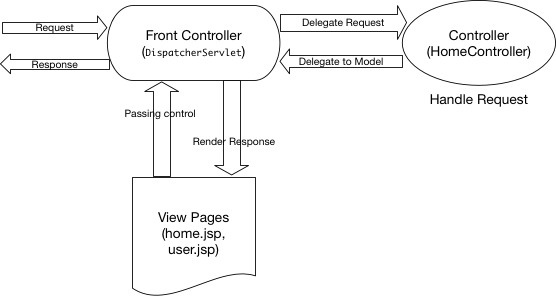
DispatcherServlet是前端控制器类,负责接收所有请求并开始处理它们。我们必须在web.xml文件中对其进行配置。它的工作是将请求传递给适当的控制器类,并在视图页面渲染响应页面后将响应发送回来。 HomeController.java将是我们的spring mvc示例应用程序中唯一的控制器类。 home.jsp,user.jsp是我们spring mvc hello world示例应用程序中的视图页面。 User.java将是我们spring mvc示例Web应用程序中唯一的模型类。
Spring MVC 示例 Hello World Eclipse 项目
下图显示了我们在 Eclipse 中的 Spring MVC 示例项目。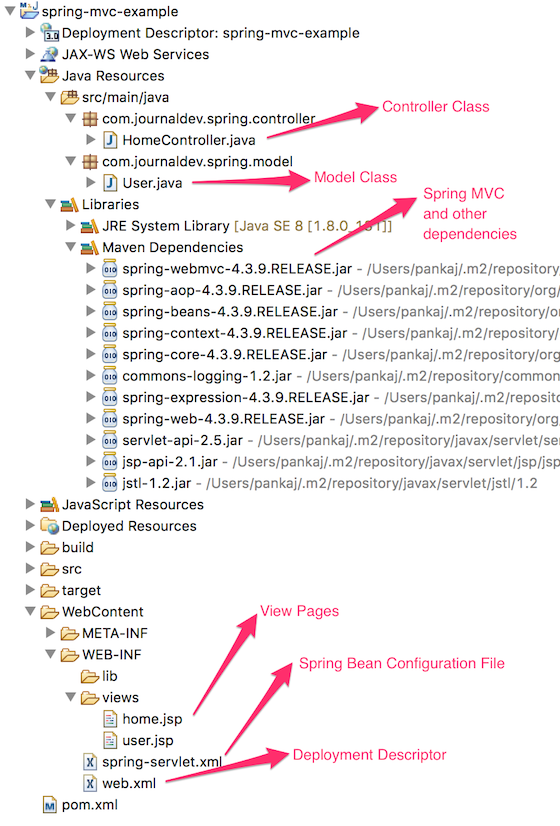 让我们开始并从头开始创建我们的项目。
让我们开始并从头开始创建我们的项目。
Spring MVC 示例 Eclipse 项目设置
由于这是一个网络应用程序,我们想要使用maven进行依赖管理,首先我们必须创建一个动态网络应用程序,然后将其转换为maven项目。以下图片展示了如何执行此操作,并准备好我们的项目骨架结构。在项目资源管理器窗口上右键单击,然后单击“新建 -> 动态Web项目”,如下图所示。 在下一个弹出页面中,提供名称为“spring-mvc-example”,其余内容应该不需要更改。
在下一个弹出页面中,提供名称为“spring-mvc-example”,其余内容应该不需要更改。 在下一个页面中,将源文件夹设置为“src/main/java”。在添加之前,您可能需要从列表中移除“src”文件夹。
在下一个页面中,将源文件夹设置为“src/main/java”。在添加之前,您可能需要从列表中移除“src”文件夹。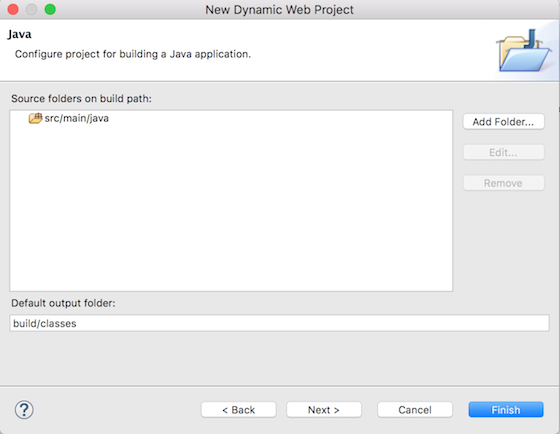 接下来是网络模块页面,将应用程序的上下文根设置为“spring-mvc-example”,并确保勾选“生成web.xml部署描述符”选项。
接下来是网络模块页面,将应用程序的上下文根设置为“spring-mvc-example”,并确保勾选“生成web.xml部署描述符”选项。 单击“完成”,您将在eclipse项目资源管理器中拥有一个新的动态Web项目。
单击“完成”,您将在eclipse项目资源管理器中拥有一个新的动态Web项目。
将动态Web项目转换为Maven项目
我们希望使用Maven来轻松管理我们的Spring MVC依赖项。因此,让我们将我们的Web项目转换为Maven。右键单击项目,选择“配置 -> 转换为Maven项目”。 接下来按照下面所示提供pom.xml配置。
接下来按照下面所示提供pom.xml配置。 我们的Maven Web应用程序项目骨架代码已准备就绪。现在我们可以开始对其进行更改并创建我们的Spring MVC Hello World示例应用程序。
我们的Maven Web应用程序项目骨架代码已准备就绪。现在我们可以开始对其进行更改并创建我们的Spring MVC Hello World示例应用程序。
向pom.xml添加Spring MVC依赖项
我们需要在pom.xml中添加spring-web和spring-webmvc依赖项,还需要添加servlet-api、jsp-api和jstl依赖项。我们最终的pom.xml文件将如下所示。
<project xmlns="https://maven.apache.org/POM/4.0.0" xmlns:xsi="https://www.w3.org/2001/XMLSchema-instance"
xsi:schemaLocation="https://maven.apache.org/POM/4.0.0 https://maven.apache.org/xsd/maven-4.0.0.xsd">
<modelVersion>4.0.0</modelVersion>
<groupId>com.journaldev.spring.mvc</groupId>
<artifactId>spring-mvc-example</artifactId>
<version>0.0.1-SNAPSHOT</version>
<packaging>war</packaging>
<name>Spring MVC Example</name>
<description>Spring MVC Hello World Example</description>
<!-- Add Spring Web and MVC dependencies -->
<dependencies>
<dependency>
<groupId>org.springframework</groupId>
<artifactId>spring-webmvc</artifactId>
<version>4.3.9.RELEASE</version>
</dependency>
<dependency>
<groupId>org.springframework</groupId>
<artifactId>spring-web</artifactId>
<version>4.3.9.RELEASE</version>
</dependency>
<!-- Servlet -->
<dependency>
<groupId>javax.servlet</groupId>
<artifactId>servlet-api</artifactId>
<version>2.5</version>
<scope>provided</scope>
</dependency>
<dependency>
<groupId>javax.servlet.jsp</groupId>
<artifactId>jsp-api</artifactId>
<version>2.1</version>
<scope>provided</scope>
</dependency>
<dependency>
<groupId>javax.servlet</groupId>
<artifactId>jstl</artifactId>
<version>1.2</version>
</dependency>
</dependencies>
<build>
<plugins>
<plugin>
<artifactId>maven-compiler-plugin</artifactId>
<version>3.6.1</version>
<configuration>
<source>1.8</source>
<target>1.8</target>
</configuration>
</plugin>
<plugin>
<artifactId>maven-war-plugin</artifactId>
<version>3.0.0</version>
<configuration>
<warSourceDirectory>WebContent</warSourceDirectory>
</configuration>
</plugin>
</plugins>
<finalName>${project.artifactId}</finalName> <!-- added to remove Version from WAR file -->
</build>
</project>
请注意构建中的finalName配置,以便我们的WAR文件名称不包含版本详情。当项目由Eclipse构建时,您会注意到所有的JAR文件都显示在maven依赖项部分。
Spring MVC DispatcherServlet作为前端控制器
我们必须将Spring MVC框架添加到我们的Web应用程序中,为此,我们需要在web.xml中配置DispatcherServlet,如下所示。
<?xml version="1.0" encoding="UTF-8"?>
<web-app xmlns:xsi="https://www.w3.org/2001/XMLSchema-instance" xmlns="https://java.sun.com/xml/ns/javaee" xsi:schemaLocation="https://java.sun.com/xml/ns/javaee https://java.sun.com/xml/ns/javaee/web-app_3_0.xsd" id="WebApp_ID" version="3.0">
<display-name>spring-mvc-example</display-name>
<!-- Add Spring MVC DispatcherServlet as front controller -->
<servlet>
<servlet-name>spring</servlet-name>
<servlet-class>
org.springframework.web.servlet.DispatcherServlet
</servlet-class>
<init-param>
<param-name>contextConfigLocation</param-name>
<param-value>/WEB-INF/spring-servlet.xml</param-value>
</init-param>
<load-on-startup>1</load-on-startup>
</servlet>
<servlet-mapping>
<servlet-name>spring</servlet-name>
<url-pattern>/</url-pattern>
</servlet-mapping>
</web-app>
contextConfigLocation init-param用于提供spring bean配置文件的位置。
Spring MVC示例Bean配置文件
下一步是创建Spring Bean配置文件spring-servlet.xml,如下所示。
<?xml version="1.0" encoding="UTF-8"?>
<beans:beans xmlns="https://www.springframework.org/schema/mvc"
xmlns:xsi="https://www.w3.org/2001/XMLSchema-instance" xmlns:beans="https://www.springframework.org/schema/beans"
xmlns:context="https://www.springframework.org/schema/context"
xsi:schemaLocation="https://www.springframework.org/schema/mvc https://www.springframework.org/schema/mvc/spring-mvc.xsd
https://www.springframework.org/schema/beans https://www.springframework.org/schema/beans/spring-beans.xsd
https://www.springframework.org/schema/context https://www.springframework.org/schema/context/spring-context.xsd">
<!-- DispatcherServlet Context: defines this servlet's request-processing
infrastructure -->
<!-- Enables the Spring MVC @Controller programming model -->
<annotation-driven />
<context:component-scan base-package="com.journaldev.spring" />
<!-- Resolves views selected for rendering by @Controllers to .jsp resources
in the /WEB-INF/views directory -->
<beans:bean
class="org.springframework.web.servlet.view.InternalResourceViewResolver">
<beans:property name="prefix" value="/WEB-INF/views/" />
<beans:property name="suffix" value=".jsp" />
</beans:bean>
</beans:beans>
有三个重要的配置。
annotation-driven告诉DispatcherServlet使用@Controller注释查找控制器类。context:component-scan告诉DispatcherServlet在哪里查找控制器类。InternalResourceViewResolverbean 配置用于指定视图页面的位置和使用的后缀。控制器类方法返回视图页面的名称,然后添加后缀以确定要用于呈现响应的视图页面。
Spring MVC 控制器类
我们有一个单一的控制器类来响应两个 URI – “/” 用于主页,“/user” 用于用户页面。
package com.journaldev.spring.controller;
import java.text.DateFormat;
import java.util.Date;
import java.util.Locale;
import org.springframework.stereotype.Controller;
import org.springframework.ui.Model;
import org.springframework.validation.annotation.Validated;
import org.springframework.web.bind.annotation.RequestMapping;
import org.springframework.web.bind.annotation.RequestMethod;
import com.journaldev.spring.model.User;
@Controller
public class HomeController {
/**
* Simply selects the home view to render by returning its name.
*/
@RequestMapping(value = "/", method = RequestMethod.GET)
public String home(Locale locale, Model model) {
System.out.println("Home Page Requested, locale = " + locale);
Date date = new Date();
DateFormat dateFormat = DateFormat.getDateTimeInstance(DateFormat.LONG, DateFormat.LONG, locale);
String formattedDate = dateFormat.format(date);
model.addAttribute("serverTime", formattedDate);
return "home";
}
@RequestMapping(value = "/user", method = RequestMethod.POST)
public String user(@Validated User user, Model model) {
System.out.println("User Page Requested");
model.addAttribute("userName", user.getUserName());
return "user";
}
}
请注意,为简单起见,我没有使用任何日志记录框架,如 log4j。
Spring MVC 模型类
我们有一个简单的模型类,其中包含一个变量及其 getter-setter 方法。它是一个简单的 POJO 类。
package com.journaldev.spring.model;
public class User {
private String userName;
public String getUserName() {
return userName;
}
public void setUserName(String userName) {
this.userName = userName;
}
}
Spring MVC 视图页面
我们有以下两个定义的视图页面。home.jsp
<%@ page language="java" contentType="text/html; charset=UTF-8"
pageEncoding="UTF-8"%>
<%@ taglib uri="https://java.sun.com/jsp/jstl/core" prefix="c"%>
<%@ page session="false"%>
<html>
<head>
<title>Home</title>
</head>
<body>
<h1>Hello world!</h1>
<P>The time on the server is ${serverTime}.</p>
<form action="user" method="post">
<input type="text" name="userName"><br> <input
type="submit" value="Login">
</form>
</body>
</html>
user.jsp
<%@ page language="java" contentType="text/html; charset=UTF-8"
pageEncoding="UTF-8"%>
<!DOCTYPE html PUBLIC "-//W3C//DTD HTML 4.01 Transitional//EN" "https://www.w3.org/TR/html4/loose.dtd">
<html>
<head>
<meta http-equiv="Content-Type" content="text/html; charset=UTF-8">
<title>User Home Page</title>
</head>
<body>
<h3>Hi ${userName}</h3>
</body>
</html>
注意,Spring MVC 负责将表单变量映射到模型类变量,这就是为什么两个地方都有相同的变量名。就是这样,我们的 Spring MVC 示例项目已经准备好部署和测试了。
Spring MVC Eclipse 项目部署
我们可以使用 Eclipse 导出为 WAR 文件选项直接部署到任何正在运行的 Tomcat 服务器的 webapps 目录中。但是,您也可以使用命令行构建项目,然后将其复制到您喜欢的 Servlet 容器部署目录中。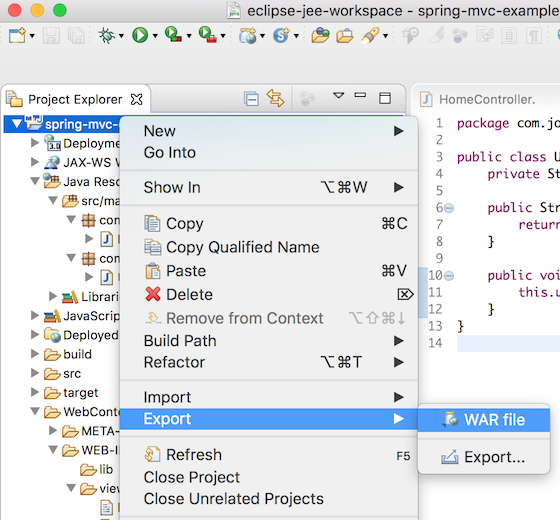
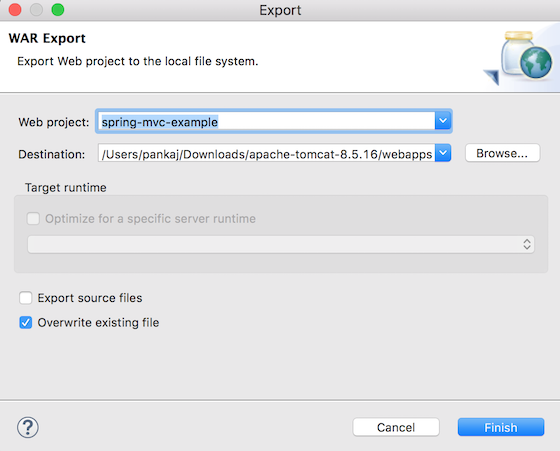
Spring MVC 示例测试
一旦部署了Spring MVC项目,我们可以在https://localhost:8080/spring-mvc-example/访问主页。根据需要更改Tomcat端口和上下文根。这就是Spring MVC示例的全部内容,我已尽量保持简单。但如果您仍然遇到任何问题,请通过评论告诉我,我会尽力帮助您解决。您可以从下面的链接下载最终的Spring MVC示例项目。
参考:官方页面
Source:
https://www.digitalocean.com/community/tutorials/spring-mvc-example













